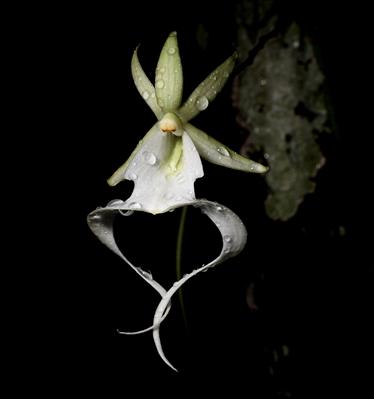The "Ghost Orchid Whisperer" is a news blog dedicated to providing current information on recent discoveries of rare and or endangered Orchid species, found both locally and abroad.
To get things started, here is a little history on its acting member with "The Ghost Orchid Whisperer". I was raised by a parent, who was/is an Orchid collector, grower, and breeder. Also, she is a talented artist who paint's portraits of orchids in both oil's and water colors. And is also an active member of the British Columbia Orchid Society. And, in my opinion, if you want to know anything about Orchids she is the person to consult. And, as such she is both my inspiration and my exclusive source of information for this endeavor.
Having grown-up, surrounded by Orchids, I often wondered, what was all the big fuss about, after all "there just plants aren’t they"?
And, this certainly seemed to be the case until becoming the new owner of my very own Phaeonopsis. Now, she is not as rare as say for example, “The Ghost Orchid”, but when she blooms bursts of purple hue petals, She is just as stunning however as the most rarest of flowers.
It is said that there are twenty two thousand or more accepted orchid species in existence. And, there are about eight hundred new orchid species added per year. The largest type is that of the Bulbophyllum which has two thousand orchid species alone. These numbers do not include all the hybrids or cultivators that scientists have developed.
Orchids are one of the most ancient plants still in existence. Their life began in primordial times, with the species being highly adaptable so that the orchid could grow and change as the Earth itself did. Rare orchids are being protected as different ecosystems collapse.
With their ingrown sense of survival, the orchid lives in every climate, excluding solid ice. They do not necessarily need soil, as they can grow symbiotically in nature. Orchids will live in trees, mountains, bogs, grasslands, rocks, and forests. The roots of orchids will grow in the air, as well as laterally. Today there are over 35,000 orchid species living in every corner of the world. If the orchid doesn't have what it needs, the plant is clever enough to make the world around it create certain living conditions. Ants have been coerced into living with the orchid so that the acidic content can be put to use within the plant. Since orchids have existed before the birds and the bees, they have found a way to mimic pollinators to trick them into propagating.
Following are some examples of rare orchids:
And, most recently there was a discovery of "The Ghost Orchid" growing high in an old cypress tree in Corkscrew Swamp Sanctuary in Naples, Southwest Florida.
Included today are photos of two endangered species of orchids. The first is called papheopedilum sukhakulii from Asia and the Prosthechea cochleata or the octopus orchid from Central America.
